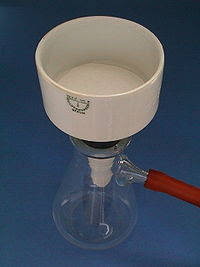Büchner funnel
00.10
Diposting oleh Melany Christy
 A Büchner funnel is a piece of laboratory equipment used in suction filtration.[1] It is traditionally made of porcelain, but glass and plastic funnels are also available. On top of the funnel-shaped part there is a cylinder with a perforated plate separating it from the funnel. The Hirsch funnel has a similar design; it is used similarly, but for smaller quantities of material. The main difference is that the plate is much smaller, while the walls of the funnel angle outward instead of being vertical. The filtration material, usually filter paper, is placed on the plate, and the filter paper is moistened with a solvent to prevent initial leakage. The liquid to be filtered is poured into the cylinder and drawn through the perforated plate by vacuum
A Büchner funnel is a piece of laboratory equipment used in suction filtration.[1] It is traditionally made of porcelain, but glass and plastic funnels are also available. On top of the funnel-shaped part there is a cylinder with a perforated plate separating it from the funnel. The Hirsch funnel has a similar design; it is used similarly, but for smaller quantities of material. The main difference is that the plate is much smaller, while the walls of the funnel angle outward instead of being vertical. The filtration material, usually filter paper, is placed on the plate, and the filter paper is moistened with a solvent to prevent initial leakage. The liquid to be filtered is poured into the cylinder and drawn through the perforated plate by vacuumsuction.
The main advantage in using this type of filtration is that it proceeds much more quickly (several orders of magnitude) than simply allowing the solvent to drain through the filter medium via the force of gravity. It is essential that the amount of solvent being used be limited to less than what would overflow the flask, otherwise the solvent will be drawn into the vacuum equipment. If the vacuum is provided by a water flow device, an overflow of the solvent could result in the spilling of a hazardous solvent into the wastewater stream, a potential violation of the law, depending on the solvent. The potential for overflow and the potential for water to be drawn back into the flask can be reduced by using a trap between the flask and the vacuum source.
 It is used in organic chemistry labs to assist in collecting recrystallized compounds. The suction allows the wet recrystallized compound to dry out such that the pure dried crystal compound is left remaining. However, it is often the case that further drying is required, by an oven or other means, in order to remove as much residual solvent as possible.
It is used in organic chemistry labs to assist in collecting recrystallized compounds. The suction allows the wet recrystallized compound to dry out such that the pure dried crystal compound is left remaining. However, it is often the case that further drying is required, by an oven or other means, in order to remove as much residual solvent as possible.
It is often used in combination with a Büchner flask, Büchner ring and sinter seals. A vacuum tight seal and stability of the Büchner flask and filter are essential during the filtration process. A Büchner ring can be used with Büchner funnels, flasks, glass crucibles and gooch crucibles. The wide flange and large surface contact ensures an excellent vacuum tight seal whilst the rings are easy to remove and offer excellent support to even the largest funnels
It is commonly thought to be named for the Nobel Laureate, Eduard Buchner, but it is actually named for the industrial chemist Ernst Büchner.

Posting Komentar